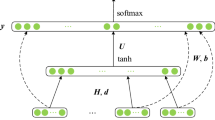Abstract
Meta-embedding is a technology to create a new embedding by combining different existing embeddings, which captures complementary aspects of lexical semantics. The supervised learning of task-specific meta-embedding is a convenient way to make use of accessible pre-trained word embeddings. However, the weights for different word embeddings are hard to calculate. We introduce the dynamic task-specific factors into meta-embedding (DTFME), which are utilized to calculate appropriate weights of different embedding sets without increasing complexity. Then, we evaluate the performance of DTFME on sentence representation tasks. Experiments show that our method outperforms prior works in several benchmark datasets.
Access this chapter
Tax calculation will be finalised at checkout
Purchases are for personal use only
Similar content being viewed by others
Notes
- 1.
Based on facebookresearch/DME: https://github.com/facebookresearch/DME.
- 2.
This is a common distinction, see e.g., the SNLI leaderboard at https://nlp.stanford.edu/projects/snli/.
References
Bansal, M., Gimpel, K., Livescu, K.: Tailoring continuous word representations for dependency parsing. In: ACL, pp. 809–815 (2014)
Bojanowski, P., Grave, E., Joulin, A., Mikolov, T.: Enriching word vectors with subword information. In: TACL, pp. 135–146 (2017)
Bowman, S.R., Angeli, G., Potts, C., Manning, C.D.: A large annotated corpus for learning natural language inference. arXiv preprint arXiv:1508.05326 (2015)
Chen, X., Liu, Z., Sun, M.: A unified model for word sense representation and disambiguation. In: EMNLP, pp. 1025–1035 (2014)
Choi, H., Cho, K., Bengio, Y.: Context-dependent word representation for neural machine translation. Comput. Speech Lang. 45, 149–160 (2017)
Conneau, A., Kiela, D., Schwenk, H., Barrault, L., Bordes, A.: Supervised learning of universal sentence representations from natural language inference data. arXiv (2017)
Devlin, J., Chang, M.W., Lee, K., Toutanova, K.: Bert: pre-training of deep bidirectional transformers for language understanding. arXiv (2018)
Kiela, D., Wang, C., Cho, K.: Dynamic meta-embeddings for improved sentence representations. In: EMNLP (2018)
Kingma, D.P., Ba, J.: Adam: a method for stochastic optimization. arXiv (2014)
Kocmi, T., Bojar, O.: An exploration of word embedding initialization in deep-learning tasks. arXiv preprint arXiv:1711.09160 (2017)
Levy, O., Goldberg, Y., Dagan, I.: Improving distributional similarity with lessons learned from word embeddings. In: TACL (2015)
Li, J., Li, J., Fu, X., Masud, M.A., Huang, J.Z.: Learning distributed word representation with multi-contextual mixed embedding. Knowl. Based Syst. 106, 220–230 (2016)
Lin, Z., et al.: A structured self-attentive sentence embedding. arXiv (2017)
Liu, P., Qiu, X., Huang, X.: Learning context-sensitive word embeddings with neural tensor skip-gram model. In: IJCAI, pp. 1284–1290 (2015)
McCann, B., Bradbury, J., Xiong, C., Socher, R.: Learned in translation: contextualized word vectors. In: Advances in Neural Information Processing Systems, pp. 6294–6305 (2017)
Melamud, O., Goldberger, J., Dagan, I.: context2vec: Learning generic context embedding with bidirectional LSTM. In: Proceedings of The 20th SIGNLL Conference on Computational Natural Language Learning, pp. 51–61 (2016)
Mikolov, T., Chen, K., Corrado, G., Dean, J.: Efficient estimation of word representations in vector space. arXiv preprint arXiv:1301.3781 (2013)
Muromägi, A., Sirts, K., Laur, S.: Linear ensembles of word embedding models. arXiv preprint arXiv:1704.01419 (2017)
Pennington, J., Socher, R., Manning, C.: Glove: global vectors for word representation. In: EMNLP, pp. 1532–1543 (2014)
Peters, M.E., et al.: Deep contextualized word representations. arXiv (2018)
Pilehvar, M.T., Camacho-Collados, J., Navigli, R., Collier, N.: Towards a seamless integration of word senses into downstream NLP applications. arXiv (2017)
Qiu, L., Tu, K., Yu, Y.: Context-dependent sense embedding. In: EMNLP (2016)
Rendle, S.: Factorization machines. In: ICDM, pp. 995–1000 (2010)
Schnabel, T., Labutov, I., Mimno, D., Joachims, T.: Evaluation methods for unsupervised word embeddings. In: EMNLP (2015)
Socher, R., et al.: Recursive deep models for semantic compositionality over a sentiment treebank. In: EMNLP (2013)
Tsvetkov, Y., Faruqui, M., Ling, W., Lample, G., Dyer, C.: Evaluation of word vector representations by subspace alignment. In: EMNLP (2015)
Wang, Z., Hamza, W., Florian, R.: Bilateral multi-perspective matching for natural language sentences. In: IJCAI (2017)
Yang, Z., Dhingra, B., Yuan, Y., Hu, J., Cohen, W.W., Salakhutdinov, R.: Words or characters? fine-grained gating for reading comprehension. arXiv (2016)
Yin, W., Schütze, H.: Learning meta-embeddings by using ensembles of embedding sets. arXiv preprint arXiv:1508.04257 (2015)
Author information
Authors and Affiliations
Corresponding author
Editor information
Editors and Affiliations
Rights and permissions
Copyright information
© 2019 Springer Nature Switzerland AG
About this paper
Cite this paper
Xie, Y., Hu, Y., Xing, L., Wei, X. (2019). Dynamic Task-Specific Factors for Meta-Embedding. In: Douligeris, C., Karagiannis, D., Apostolou, D. (eds) Knowledge Science, Engineering and Management. KSEM 2019. Lecture Notes in Computer Science(), vol 11776. Springer, Cham. https://doi.org/10.1007/978-3-030-29563-9_7
Download citation
DOI: https://doi.org/10.1007/978-3-030-29563-9_7
Published:
Publisher Name: Springer, Cham
Print ISBN: 978-3-030-29562-2
Online ISBN: 978-3-030-29563-9
eBook Packages: Computer ScienceComputer Science (R0)




